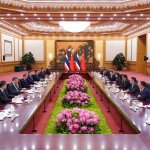
It was less than two days into 2024 when Song Tao, the director of China’s Taiwan Affairs Office, called on all Taiwanese to promote “peaceful reunification” with the mainland. But down in the text, the New Year’s message posted to the office’s website had not-so-subtle wording, as Song warned “the motherland will eventually be reunified, and it will inevitably be reunified.”
The message came less than two weeks before Taiwan held its presidential and parliamentary elections and coincided with Chinese President Xi Jinping’s message that reunification was an all but foregone conclusion. The thin rhetorical veneer of peaceful reunification has been gradually but significantly replaced with language that is more crisp in “advancing the cause of reunification.”

This week, upon releasing budget figures at the opening of the National People’s Congress, Premier Li Qiang dropped mention of “peaceful reunification” in his government report, according to a Reuters analysis of his speech. Li reiterated China’s call for “reunification” with Taiwan but added emphasis that it wants to “be firm” in doing so and dropped the descriptor “peaceful”, which had been used in previous reports, Reuters noted.
To be sure, it was not the first time a top Chinese official had omitted the word “peaceful” when referring to Taiwan “reunification.” The firmer language has been repeatedly used by Chinese state officials and has been a mainstay in Chinese Communist Party (CCP) speeches, including in Xi’s speech before the 20th Party Congress in October 2022.
In the president’s words then, he and his countrymen “firmly” grasp “the leading position and initiative in cross-Strait relations, and unswervingly promote the great cause of the reunification of the motherland, which is the goal of work on Taiwan.”
In Xi’s China, the master historical narrative is much more important than the veneer of a peaceful transition. This makes the removal of the language a reflection of current realities and an affirmation that “rejuvenation” through peaceful or more violent methods is the primary focus of the state.
In this effort, China has been consistent dating back Xi’s speech at a 2012 “Road To Renewal” exhibition, where the restoration of China takes precedence over all other objectives. Taiwan is seen as a critical element, as Beijing has called its separation a “result of weakness and chaos in our nation” as noted in a 2022 White Paper, “The Taiwan Question and China’s Reunification in the New Era.”
Reunification is also extension of the “Chinese Dream,” which is a collection of national myths and collective traumas manufactured by the state to extend beyond memory, back to the ancient Sui Dynasty of the 6th Century and the glories of the Ming Dynasty, which lasted until 1644. Failure to hold Taiwan is a part of China’s trauma-based nationalism.
So injurious to the Chinese Dream is the threat of failure that “compatriots” in Taiwan who were delicately described as “brothers and sisters” in 1978 are more commonly associated with conspiring to commit the most serious crimes of secession and treason.
Dead now are the remnants of Jiang Zemin’s diplomacy aimed at peaceful Cross-Strait relations, echoed in his report to the 16th Party Congress in 2002, in which the word “peaceful” was used in the Taiwan context nearly a dozen times.
The election outcome in Taiwan was a setback for China, as Democratic Progressive Party (DPP) candidate William Lai won more than 40% of the vote – even though China’s Taiwan Affairs Office had warned on the Thursday before the January weekend election that he represented Taiwan slipping “ever further away from peace and prosperity, and ever closer to war and decline.”
Now, despite economic deflation, there are steep increases in China’s defense spending, up 7.2% for 2024 at US$230.6 billion. The surge in spending comes amid stern warnings about “external interference” and opposition to separatist activities aimed at promoting Taiwanese independence.
Long gone is a much milder approach, evidenced also in Hong Kong well prior to June 2020, when the promise of “one country, two systems” was that of a “high degree of autonomy.”
The decling rhetorical use of “peaceful reunification” also marks the broader realization that Taiwan has moved farther and farther from the control of mainland China. Taiwan’s investment in South Asia and Southeast Asia in 2022 was greater than investments the self-governing island made in mainland China.
Former Taiwanese President Tsai Ing-wen has not only moved Taiwanese companies back from China, but has worked to engineer trade away from the mainland into the broader Indo-Pacific.
Taiwan’s New Southbound Policy, which targets 18 countries, almost doubled between 2016 and 2022. And the breadth of Taipei’s defense-related procurement and related military aid from the United States and other aligned countries makes the island a much more potent foe than it was 20 years ago.
With this reality, Beijing has set its sights on a reunion along the coercive terms it sets. As Taiwan becomes less interconnected and dependent on the mainland, more threats and less diplomacy are likely from Beijing.
Instead, contingency planning will continue to increase, evidenced by the recent weighing of options to blunt the effect of US sanctions in the case of a Taiwan conflict or recent mock drills simulating an island invasion by the military. While the language might simply be the removal of old rhetoric from an old, abandoned foreign policy, it also is symbolic of this new, more dangerous and volatile era.






